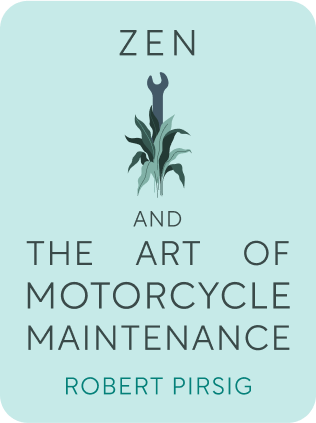

This article is an excerpt from the Shortform book guide to "Zen And The Art Of Motorcycle Maintenance" by Robert Pirsig. Shortform has the world's best summaries and analyses of books you should be reading.
Like this article? Sign up for a free trial here .
What is the church of reason in Zen and the Art of Motorcycle Maintenance? How does it affect the philosophy in the book?
The church of reason in Zen and the Art of Motorcycle Maintenance is the idea that you can find spirituality through education and learning about life. Robert Pirsig discusses the church of reason as his university.
Read more about the church of reason in Zen and the Art of Motorcycle Maintenance.
The Church of Reason
The riders arrive at the gates of Yellowstone Park and pay their fee to enter. Pirsig recalls that Phaedrus rarely visited the park even though he lived close to it when he was in Bozeman—it was too stagey for him.
Chautauqua: Phaedrus in India
Before Phaedrus wound up in Bozeman, however, Pirsig informs us he spent years studying Eastern philosophy at Benares Hindu University in India.
The experience wasn’t revolutionary for Phaedrus, at least not at the time. He was, however, exposed to a great deal of information that would influence his later thought.
One such influence was the religions of Hinduism, Buddhism, and Taoism. Phaedrus discovered that the differences among these religions were minor compared to the tensions among the major Western religions (Christianity, Islam, Judaism). The core tenet of the Eastern religions he studied was Tat tvan asi—Sanskrit for “Thou are that.” Tat tvan asi means that there is no division between who we are and what we perceive. Once a human being realizes that he is one with everything around him, it says, he has reached enlightenment.
The best way to recognize our oneness with the world is stillness—meditation. Phaedrus resisted meditating, however—he was still at the time a committed classical thinker, and there was nothing rational about meditation.
When his Indian philosophy professor, lecturing on the illusory nature of reality, asserted that the bombs in Hiroshima and Nagasaki too were illusory, Phaedrus left India wholly disenchanted. He renounced his study of philosophy and earned a degree in journalism instead. He took a sequence of writing jobs, started a family, and settled into middle-class life.
The travelers leave the park at a town called Gardiner, where they decide to spend the night. The next morning, Pirsig finds it hard to eat—they will arrive at the university where Phaedrus taught in a matter of hours, and he’s nervous.
Chautauqua: Phaedrus and the University
Pirsig remembers that Phaedrus hated to teach, mostly because he suffered from severe stage fright (he would often vomit before his classes). He didn’t appear nervous to his students, however; rather, his anxiety manifested itself as a strange, sometimes disturbing intensity. He had a reputation, and not a particularly good one, among the student body.
The college where he taught was a teaching-focused, rather than research-focused, school. Phaedrus hated that his teaching load didn’t allow time for contemplation and forced him to repeat his lessons year after year, but he nevertheless believed in the higher purpose of the university. In fact, he thought of his university as the Church of Reason
His rosy view of the school had a lot to do with the politics of Montana at the time. The government was dominated by ultra-right-wing politicians who were attacking the traditions and standards of institutions of higher learning. They infringed on the free-speech rights of the university’s faculty, abolished admissions and grading standards, and cut the university’s funding. The funding cuts were felt especially in the English Department, Phaedrus’s home department, which had been leading the fight against the government’s meddling.Phaedrus himself was a visible figure in the department’s resistance to the government. One day a student questioned him about his efforts to get the school’s accreditation revoked (Phaedrus had notified the school’s accrediting association of the government’s activities). It quickly became clear the students misunderstood the nature of accreditation: They thought that if the school lost its accreditation it would shut down.
The next day Phaedrus delivered a prepared lecture, a rarity. He told his students that the school’s losing its accreditation was similar to excommunication in Catholicism: Although the school would continue to operate much as it did before—enrolling students, arranging classes—it would lose its status as a real university. By “real university,” Phaedrus meant a state of mind, passed down through the centuries, that commits itself to the exercise of reason. The university’s accreditation affirmed that it was partaking in this tradition.
Phaedrus hypothesized that the students’ confusion stemmed from their mistaking the real university with the physical and legal institution that plays host to it (the “second university”). But the second university is just the setting for the cultivation of reason that comprises the real university. And the goal of that cultivation is the pursuit of truth.
So, when stakeholders in the second university—trustees and legislators, say—decide that they don’t like what professors are saying or doing, it’s the professors’ duty to resist these influences. The real university’s mission is not to placate the community but to pursue truth.
In his lecture, Phaedrus likened the university’s physical structures to a church building and its faculty to ministers. A church building isn’t sacred for its own sake—it’s made holy by its parishioners and their faith. And a minister’s primary goal isn’t to serve his community but to serve God (and thereby, in the long run, to do right by his congregation). Hence Phaedrus’s alternative name for the real university: the Church of Reason.
But why, when Phaedrus had already lost his own faith in rational thought’s ability to find truth, did he defend its free exercise so zealously?
Pirsig believes Phaedrus’s crisis of confidence drove him to defend the Church of Reason. We’re never fanatical about something we’re sure of—no one devotes themselves to convincing others that water will run downhill. Rather, we give ourselves to causes when they’re in doubt.
Phaedrus’s militancy took place in the late 1950s, before the rise of the hippies and the resistance to classical understanding as embodied by the Sutherlands. But he seemed to have a clairvoyant sense that the legitimacy of reason would soon come under fierce attack.
The riders reach Bozeman. Pirsig has a vague recollection of the town’s main street, but his predominant feeling is that of a tourist. At first he has some difficulty getting in touch with the DeWeeses, but he calls the college’s art department and gets directions to their home. They live at the base of the mountains outside of town; the road that leads to their house is made of deep gravel and is treacherous. The riders turn a corner and come upon a large house with an abstract iron sculpture attached to it. DeWeese is sitting under the statue, entertaining a couple.
Introductions are made all around—DeWeese already has guests over, a new art instructor at the school and his wife—and the group sits. Presently John engages DeWeese and his guest in conversation, and Pirsig zones out. Although the conversation is for the most part agreeable, Pirsig begins to notice some awkwardness developing between John and DeWeese. It concerns their respective attitudes toward Pirsig: Whereas DeWeese is gentle, John is sarcastic and teasing. The awkwardness comes to a head when John says Pirsig must have been “really crazy” to leave such a beautiful place as Bozeman. DeWeese is appalled, then angry, but Pirsig calms him with a hand gesture.
The tension stems from the contexts in which DeWeese and John know Pirsig. To John, Pirsig is just an average middle-class person with whom he drinks and rides motorcycles; to DeWeese, however, Pirsig is a serious philosopher and intellectual. What DeWeese doesn’t know is that the Pirsig he knows—Phaedrus—is no more.
(Shortform note: Up to this point, the narrative has been ambiguous with regard to how much Pirsig’s friends know about his institutionalization and treatment. For example, it isn’t clear whether John knows that Pirsig was hospitalized, and so his comments about Pirsig’s “craziness” could either be understood as obliviousness or a joke in poor taste. DeWeese, however, doesn’t know why Pirsig/Phaedrus left Bozeman, so his anger at John can’t be about John’s making light of Pirsig’s illness. Rather, DeWeese is angry because John isn’t giving Pirsig the deference he deserves.)
As the sun begins to set, the temperature drops, and DeWeese’s wife suggests the riders unpack. Once everyone is situated, dinner is served in the living room. A hard, cold wind blows outside.
After dinner, more people arrive. Eventually the topic of technical writing comes up—DeWeese is frustrated with the manual for a rotisserie he’s purchased—and Pirsig recites a favorite line from a Japanese bicycle’s assembly instructions. The instructions begin by telling their reader that assembly requires “great peace of mind.”
Pirsig notes that, unexpected as this sentiment is, it’s actually quite wise: Peace of mind and a well-maintained machine go hand in hand. When the group expresses skepticism, Pirsig elaborates.
Chautauqua: The Art of Technology
Contrary to what we might think, a machine can’t be right or wrong—rather, it either satisfies or it doesn’t. If a machine gives us peace of mind, then it’s correctly assembled and maintained, no matter what the instructions say; if it doesn’t, then either the machine needs to be repaired or we need to change our minds.
In the case of the rotisserie, DeWeese’s misgivings stem from his fear that he may not have understood the instructions completely—even if the machine functions perfectly, it may not “check out” with regard to the instructions. This matter of following the instructions exactly is bogus, because despite what we might think, there’s an infinite number of ways to assemble any machine.
What Pirsig’s listeners seem not to be aware of is that technological knowhow is inherently creative. When there are an infinite number of ways to put a machine together, then choosing one of those ways becomes an expressive and personal act. Pirsig asks us to imagine two craftsmen at work: a novice with poor skills and a master. The master is wholly concentrated on his craft, improvising at will because he is an expert in his materials, whereas the novice must constantly refer to instructions. A master craftsman, or mechanic for that matter, works like an artist—he follows no plan, and his work is completed when it matches the idea of the machine in his mind.
And so, Pirsig concludes, when DeWeese was building his rotisserie, he was actually building a sculpture. His listeners, who are all conventional artists, find this idea absurd and laugh it off.
Later, after the guests have left and Chris and the Sutherlands have gone to sleep, Pirsig and the DeWeeses return to their discussion of art and technology. What’s eating Pirsig (and spurring his Chautauquas) is the reactionary distaste for technology currently in vogue. For centuries, technology was the best means for providing human beings with some level of security—by feeding, clothing, and sheltering us more effectively and efficiently. But now that, thanks to technology, these basic human needs are assured, humans have decided that technology is soulless and ugly. From back-to-the-earth communes to environmentalism, there is a national crisis with regard to technology.
Pirsig isn’t content simply to defend technology, for he acknowledges that technology doesn’t connect with matters of the heart the way, for example, art does. (Shortform note: Pirsig’s concession here that technology is indeed the opposite of art contradicts his earlier arguments concerning technological knowledge’s inherent artistry.) What he believes is necessary, rather, is a new form of thought that transcends the binaries—art/technology, classical/romantic, reason/feeling—that set off the crisis in the first place. What he wants to create is a new form of reason.
When the DeWeeses comment that he should write his musings down, he replies that he’s been contemplating a series of talks—Chautauquas.
Pirsig, Chris, and the Sutherlands spend the next two days relaxing around the DeWeeses’. Then it’s time for the Sutherlands to head back to Minnesota. After one last round of beers in Bozeman, they say their goodbyes. Pirsig and Chris wander aimlessly around town; eventually Pirsig suggests they walk up to the university.
As they work their way toward their destination, Pirsig remembers many of the streets. When he asks Chris if he remembers, Chris recalls that he and his mother would drive around looking for Pirsig. If they found him, Pirsig would simply get in the back of the car without saying a word. Pirsig’s excuse is that he was “thinking hard.”
At the time, Pirsig tells us, Phaedrus was struggling with the subject he was teaching: rhetoric. Like his skepticism of the classical mode of understanding, he was also skeptical of the rules of composition. These rules, he decided, were based on certain writers’ habits and developed after the fact—that is, they didn’t even guide the writers who served as their best examples. The rules were also so vulnerable to exceptions and qualifications that they barely functioned as rules at all.
Pirsig and Chris head directly to the building where Pirsig used to teach. He feels the same old anxiety as they approach. They enter the building. It’s deserted. Chris gets scared and, when Pirsig refuses to leave, runs back outside.
After Chris goes, Pirsig discovers he’s having an intense flashback. He seems to have become Phaedrus. He enters Phaedrus’s old classroom and finds the room unchanged. He is staring out the window, lost in thought, when someone turns the knob behind him. It’s a woman he doesn’t recognize; but after a moment she recognizes him.
She asks to sit and contemplates Pirsig. They make small talk—she seems to be a former student or colleague of Phaedrus—and eventually she admits knowing he was in the hospital. When Pirsig tells her he’s no longer teaching, she expresses complete disbelief, then leaves abruptly.
As Pirsig is about to exit the building, he opens another door on a whim. A painting on the wall shocks him: He recognizes it immediately: It’s a painting, or rather a print, that Phaedrus bought. Pirsig realizes he’s in Phaedrus’s old office.
Suddenly he’s consumed by powerful memories of his time teaching at the college. And he remembers precisely what set Phaedrus on the path to insanity. It was his colleague’s asking him, in a singsong voice, whether he was teaching “Quality.” At first Phaedrus treated her question like the mere politeness it was. But when she mentioned it again, and then a third time, Phaedrus found himself meditating for hours on end, neglecting his work and his family. He became obsessed with “Quality”: How can human beings tell when something is “Quality”? What is “Quality”?
The church of reason is another important part of Pirsig’s philosophy.

———End of Preview———
Like what you just read? Read the rest of the world's best book summary and analysis of Robert Pirsig's "Zen And The Art Of Motorcycle Maintenance" at Shortform .
Here's what you'll find in our full Zen And The Art Of Motorcycle Maintenance summary :
- How an unnamed narrator and his son are on a cross-country motorcycle journey
- Why technology can be creative
- How to focus on what's in front of you in order to get exactly what you need






